“He is considered to be the first video artist and played a key role in the field´s development. Originally trained as a classical pianist, while studying in Germany in the 1950s he met Karlheinz Stockhausen and John Cage, along with artists Joseph Beuys and Wolf Vostell, an encounter that inspired him to make electronic art. he was a member of Fluxus and in 1964 moved to New York and collaborated with Charlotte Moorman in works that combined video, music and performance. Paik was one of the first artists to use the Sony Portapak after its introduction in 1965 and a pioneer in using video as an art medium. The television set is an iconic element of his sculptures and robots. Retrospectives include the Whitney Museum of American Art, New York (1982), an the Solomon R. Guggenheim Museum, New York (2000).”
Nam June Paik
| i |

| last name: | Paik |
| first name: | Nam June |
| birthday: | June 20, 1932 |
| birth-place: | Seoul (South Korea) |
| death date: | January 29, 2006 |
| died in: | Miami (USA) |
Summary
Biography
| June 20th, 1932 | Born in Seoul (Korea), the fifth son of a textile manufacturer |
| 1950 | The Paik family flees from the Korean War, first to Hong Kong, and later to Japan |
| 1956 | Paik graduates from the University of Tokyo, concluding his studies of the History of Art and the History of Music with a thesis on Arnold Schonberg |
| 1956-58 | Studies the History of Music at Munich University; meets Karlheinz Stockhausen; studies Composition at Freiburg Conservatory |
| 1958-63 | Meets John Cage; works in the Studio fur elektronische Musik at WDR, Cologne |
| 1959-62 | Has appearances with pieces of his action music; Stockhausen’s “Originale” is performed in Cologne |
| 1963 | Participates in “Fluxus. Internationale Festspiele neuester Musik”, Wiesbaden; “Exposition of Musik / Electronic Television”, the first exhibition including TV monitors, is shown at Galerie Parnass, Wuppertal |
| 1963-64 | Travels to Japan; meets Shuya Abe; experiments with electromagnets and color television; visits New York, collaborates with Charlotte Moorman |
| 1965 | First solo exhibition “Electronic Art” in the USA at Galeria Bonino, New York Nov. 23-Dec. 11. Brochure, with text by Paik. Buys the first portable video recorder |
| 1966-69 | First multi-monitor installations; works with magnetically distorted TV recordings; “Electronic Opera No. 1” is performed at the live program “The Medium is the Medium”, GBH-TV, Boston |
| 1969-70 | With Shuya Abe, constructs the video synthesizer |
| 1971 | Works at WNET’s TV lab, New York |
| Since 1979 | Chair at Staatliche Kunstakademie, Dusseldorf |
| January 1st, 1984 | Satellite broadcast of “Good Morning Mr. Orwell” from the Centre Pompidou, Paris, and a WNET-TV studio, New York |
| 1987 | Elected a member of the Akademie der Kunste, Berlin |
| 1988 | Erects a media tower, “The more the better”, from 1003 monitors for the Olympic Games at Seoul |
| 1990 | “Video Arbor” is put up in Philadelphia as a sculpture for the public sector |
| 1991-92 | Double exhibition “Video Time – Video Space” at Kunsthalle Basel and Kunsthalle Zurich, subsequently shown in Dusseldorf and Vienna |
| 1993 | Nam June Paik with Hans Haake represents Germany in XLV Venice Biennale d’ Arte |
| January 29th, 2006 | Dies at the age of 73 years in Miami, USA. |
| Awards | Received numerous grants and awards from, inter alia, the Guggenheim Museum, the Rockefeller Foundation, and the American Film Institute; Will Grohmann Award, Goslar Emperor’s Ring, UNESCO’s Picasso Medal, Goslar Kaiserringes Award, Kyoto Award, National Arts Club Award. |
| Retrospectives | Kolnischer Kunstverein (1976), Cologne The Whitney Museum of American Art (1982), New York The Worlds of Nam June Paik (2000) at the Solomon R. Guggenheim Museum, New York; Ho-Am Art Gallery, Seoul and the Rodin Gallery, Seoul. |
Works
Exhibitions
References
- Herzogenrath, Wulf & Nierhoff-Wielk, Barbara, eds. 2007. Ex Machina - Frühe Computergrafik bis 1979. Die Sammlung Franke und weitere Stiftungen in der Kunsthalle Bremen. Herbert W. Franke zum 80. Geburtstag. Berlin:Deutscher Kunstverlag
- Krueger, Myron W. 1983. Artificial Reality. Reading, MA, USA:Addison-Wesley
- Noll, A. Michael 2015. Paik at bell labs.
- Reichardt, Jasia, et al., Brown, Paul, et al., eds. 2008. White Heat Cold Logic: British Computer Art 1960-1980. Cambridge, MA:MIT Press
Illustrations
Comments
enter new comment




